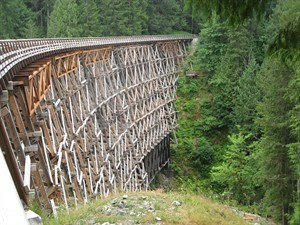
Historic Kinsol Trestle is seen in this undated photo near Shawnigan Lake, B.C. The promise of big dollars from big trees on southern Vancouver Island at the turn of the century spurred local loggers, farmers and labourers to build one of the world's largest and spectacular wooden railway trestles in the world. THE CANADIAN PRESS/Dirk Meissner
August 13, 2012 - 5:00 AM
SHAWNIGAN LAKE, B.C. - The promise of big dollars from big trees on southern Vancouver Island at the turn of the century spurred local loggers, farmers and labourers to build one of the world's largest and spectacular wooden railway trestles in the world.
The curving 188-metre long, 38-metre high Kinsol Trestle spanning the Koksilah River canyon near Shawnigan Lake allowed steam trains to haul the giant coastal cedars and firs out of the rain forest.
But times changed and the last train crossed the trestle in 1979.
Abandoned, left to rot for years and destined to be torn down in 2006, locals again united to preserve the trestle's value and mounted campaigns to preserve its heritage value by saving the trestle and keeping as much of its original structure as possible.
Today, and more than $7 million later, the Kinsol Trestle is a historic and grandiose link to hundreds of kilometres of idyllic walking, hiking, biking and horseback riding trails that form part of the nationwide Trans-Canada Trail.
"It is amazing to think of those 55 men out there 100 years ago building something like that without the hard hats, without the cranes, without the steel boots," says Lori Treloar, Shawnigan Lake Museum curator.
"Local men building that," she said. "It took them three years at roughly a cost of $26,000 and the rehabilitation almost 100 years later was closer to $7 million. That's progress."
Walking the trail to the trestle is easy and it's free; so is parking.
The trail covers the original Canadian National Railway rail bed and it takes about 10 minutes of leisurely walking to reach the Kinsol Trestle.
While walking, it's easy to imagine a steam train chugging through the forest, rounding the bend and sounding its whistle as it approaches the trestle.
The railway tracks are gone now, making it a breeze and a pleasure to walk, bike or ride a horse across the trestle.
Viewing stations on the trestle allow visitors to safely leave the main path and step out onto a secure perch and look down into the canyon or gaze out into the expanse of green forest as the river rushes below.
Picnic tables are nearby and there are trails that lead down to the river bottom. A look upwards truly reveals the beauty and complexity of the wooden trestle, which looks like a giant-sized version of a match-stick bridge.
"The last train went over in June 1979 and people in the community tried to save it, to have it designated heritage, but to no avail," said Treloar.
It took more than 30 years, but last summer the rehabilitated trestle — transformed from rail trestle to public walkway — opened, and it hasn't looked back, she said. People are coming in droves from around the world.
"The numbers haven't let up," said Treloar. "On our Shawnigan Lake website, nine out of 10 hits are looking for information on the trestle."
Brian Farquhar, the Cowichan Valley Regional District's trails and parks manager, said the rehabilitated trestle connects about 100 kilometres of public trails on southern Vancouver Island between Victoria and Nanaimo.
"The Kinsol Trestle has been a missing link in the Cowichan Valley," he said. "It has certainly been a project and a result that has been beyond our wildest dreams, in terms not only of the people of the valley and Vancouver Island, but for people coming to the island and making it part of their tour."
Farquhar said the trestle, with its six-degree curve and bent wood beams was an engineering marvel when first built, and today's rehabilitation is equally ingenious by keeping much of the original structure intact.
"The innovative engineering approach was to completely rebuild 17 of the 46 individual bents throughout the trestle to support the new pedestrian walkway structure," he said. "When you look at the trestle now, it looks identical to what was there before, except for it has newer pieces of wood here and there."
Shawnigan Lake is located about 30 kilometres northwest of Victoria. The Shawnigan Lake turn-off from the Island Highway is clearly marked and driving through the village of Shawnigan Lake takes visitors to the trestle's parking areas.
If you plan on seeing the Kinsol Trestle, before you go check out www.shawniganlakemuseum.com or www.cvrd.bc.ca, parks.
News from © The Canadian Press, 2012